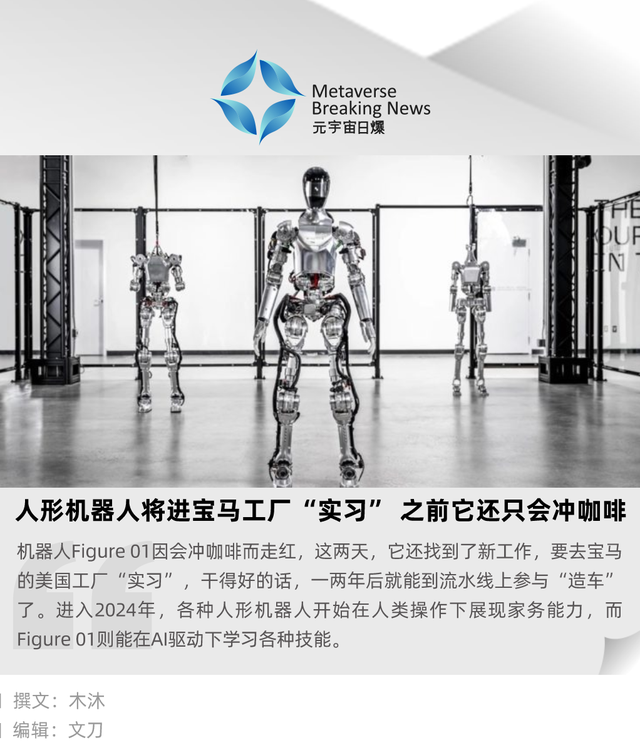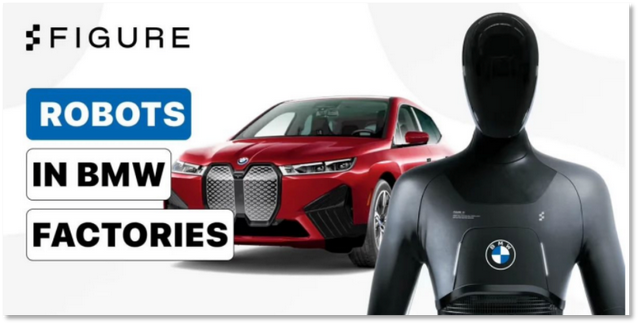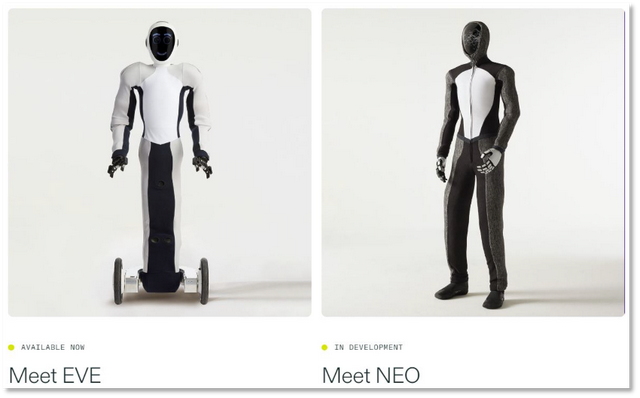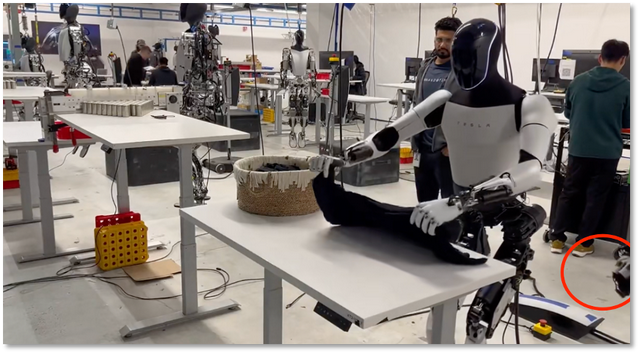
Recently, a robot named "Figure 01" became popular for making coffee. These days, it has found a new job and will be "interning" at BMW's US factory. If it performs well, it will be able to join the assembly line and participate in "car making" in one or two years.
Figure 01 is a masterpiece of the startup company Figure, which was established only a year ago and mainly develops and manufactures humanoid robots. The company is valued at over $400 million. Recently, Figure reached an important agreement with the well-known car manufacturer BMW to introduce the Figure 01 robot into BMW's factory in Spartanburg, South Carolina later this year.
Stanford's robot can cook shrimp, Tesla's Optimus Prime robot can do household chores under human control, and what sets Figure 01 apart is its strong autonomous learning ability. It can learn operational skills by watching videos, which means its skills will become increasingly rich through learning.
If the forefront of technology in 2023 is led by ChatGPT's natural language AI model, then in 2024, the forefront is likely to be robots empowered by AI models. Various robots with the ability to serve humans will continue to emerge, no longer in the form of animals like dogs and snakes, but directly in humanoid form, assisting or even replacing humans in physical labor.
Figure 01 Masters Skills by Watching Videos
Just entering 2024, various humanoid robots with unique skills are emerging one after another. There is the Stanford shrimp-cooking robot, Tesla's laundry-folding robot, and now the coffee-making robot Figure 01.
Opening the lid, inserting a coffee pack, and pressing the start button, Figure 01 performs the whole process very smoothly. Unlike videos of other robots doing household chores, the video of Figure 01 making coffee has not been accelerated.
Of course, Figure 01 is still not as powerful as Iron Man's "Jarvis," but "Little Jarvis" only exists in movies, while Figure 01 has already entered reality with the development of artificial intelligence.
It is completely driven by AI. Don't underestimate this, because with AI, Figure 01 no longer needs preset programs to complete tasks. AI has injected it with powerful learning ability. According to the official statement, Figure 01 only needs to watch a demonstration video by humans and undergo 10 hours of end-to-end training to learn the operational skills from the video and then independently complete the task.
Making coffee is just the first step to prove Figure 01's self-learning ability. Figure, the development company, stated that as long as it is given enough time, it can tackle more complex tasks. How complex? Figure directly provided an answer through a recent collaboration.
On January 18 this year, Figure announced that it will send this robot to BMW's Spartanburg factory for a pilot application, mainly to replace humans in performing high-risk tasks.

Figure collaborates with BMW to introduce Figure 01 into the car factory
BMW's Spartanburg factory, located in South Carolina, USA, is the main assembly plant for BMW X series and Z series. More than 300 robots are used in the production of the BMW X6's body at this factory, with operations such as installing car windows being performed by robots, except for the side windows, which are manually installed. This has reduced processing time by more than half.
The Figure 01 robot, which will soon enter the BMW factory to perform hazardous tasks, is 5 feet 6 inches tall, equivalent to 1.67 meters in height. It can carry a weight of 19.95 kilograms, which is almost the weight of a large water cooler. After charging, it can operate for 5 hours at a walking speed of 4.3 kilometers per hour.
"The potential of general-purpose robots has not been fully explored," said Brett Adcock, CEO and founder of Figure. He stated that their robots can increase productivity, reduce costs, and create a safer and more consistent working environment for the company.
It is reported that in the initial stage, Figure 01 will start with "a small amount of work." As time goes on, these AI-driven humanoid robots will be involved in more manufacturing tasks, including box handling, picking and placing tasks, tray loading, and other positions that car manufacturers have struggled to retain human workers in.
If the goal is achieved, the deployment of Figure 01 will increase, and it is expected to take 12-24 months to truly integrate into BMW's manufacturing process, including body workshops, sheet metal, and warehouses.
A Large Number of Humanoid Robots Are on the Way
Figure 01 is just one of many humanoid robots. In 2024, more humanoid robots are on the way.
The newly established Chinese company MagicLab has launched a sports-type all-electric robot, which can already perform gymnastic movements such as backflips and graceful get-ups.
Norwegian humanoid robot startup 1X Technologies has introduced two products, EVE and NEO, this year. EVE has been commercially deployed in some regions of the United States and Europe, capable of patrolling, handling, navigating, and standing guard, acting as a robotic security guard. NEO is still in the research and development stage and is said to be soft and lightweight like a human, able to communicate with humans through facial expressions.

1X Technologies introduces two humanoid robots
The veteran in the robot field, DeepMind, is continuously developing at the "brain" level of humanoid robots. Its three key research projects related to robots, AutoRT, SARA-RT, and RT-Trajectory, will effectively improve the data collection efficiency and generalization ability of robots.
Among them, AutoRT is a robot training system that can simultaneously guide multiple robots to perform diverse tasks in different environments; SARA-RT is a system that enhances the efficiency of robot Transformer models; and RT-Trajectory is a model that achieves the generalization ability of robots, allowing robots to learn control strategies from 2D trajectory images.
Emphasizing its position as an "artificial intelligence/robot company," Tesla, which has recently gained attention, released a video of its humanoid robot "Optimus Prime" folding clothes. In the video, "Optimus Prime" stands in front of a table, takes out a black T-shirt from a box, and then slowly folds it neatly.
However, this video has been questioned. Some netizens pointed out that Musk used CGI (3D animation) technology to fake the video. Others noticed that a mechanical arm was exposed in the video, leading some to claim that this series of clothes-folding actions may not have been completely autonomously performed by the robot, but rather the result of external remote control.

Tesla robot video shows a mechanical arm
After being "exposed," Musk honestly admitted that "Optimus Prime" is currently unable to autonomously fold clothes, but "it will definitely be able to in the future."
In terms of technological advancement, "Optimus Prime" has made some progress. It has added touch sensors, which can accurately obtain and analyze information about the shape, size, position, and direction of the object it touches, especially with better judgment of pressure. For example, the robot will not crush an egg when picking it up with its "hand."
Most robots still cannot achieve autonomous operation.
For example, the Stanford household robot Mobile ALOHA, which became popular on video platforms, uses an automatic + remote control learning mode. It requires humans to first operate the mechanical arm to demonstrate a task, and then Mobile ALOHA can learn similar actions.
Moreover, Mobile ALOHA cannot learn all tasks just by demonstration. According to a paper, its success rate in learning to wipe red wine stains is 95%, pushing chairs is 80%, and cooking shrimp is only 40%. In addition, it can be observed that the video is played at double speed, indicating that in a real scenario, Mobile ALOHA's speed in doing household chores is likely very slow.
In the case of Figure 01, its autonomous learning ability has been enhanced with the support of AI. Figure stated that their robot is completely driven by AI, capable of handling general tasks, and ultimately achieving the learning and interaction between the robot and the environment. It is said that Figure 01 learned to make coffee by watching a video and did not require remote human operation.
NVIDIA's senior research scientist Jim Fan once predicted that 2024 would be the "year of robots," and the AI that was hot last year and this year will be the accelerator for the intelligence of humanoid robots.
免责声明:本文章仅代表作者个人观点,不代表本平台的立场和观点。本文章仅供信息分享,不构成对任何人的任何投资建议。用户与作者之间的任何争议,与本平台无关。如网页中刊载的文章或图片涉及侵权,请提供相关的权利证明和身份证明发送邮件到support@aicoin.com,本平台相关工作人员将会进行核查。




